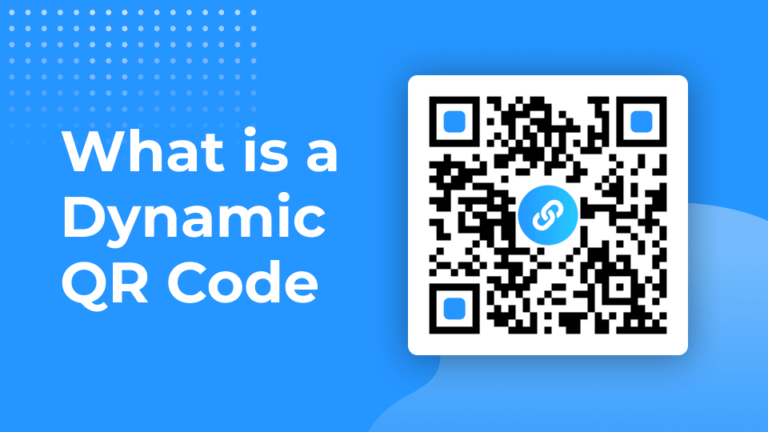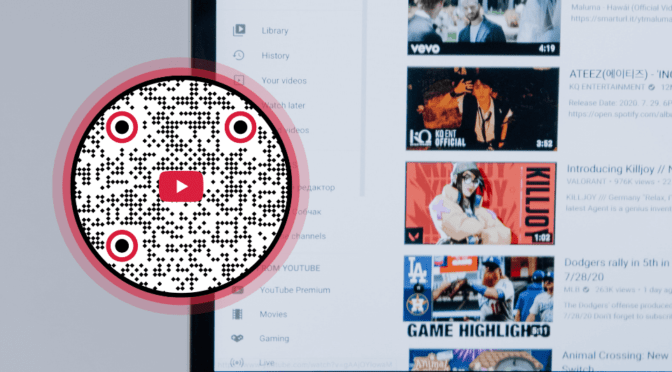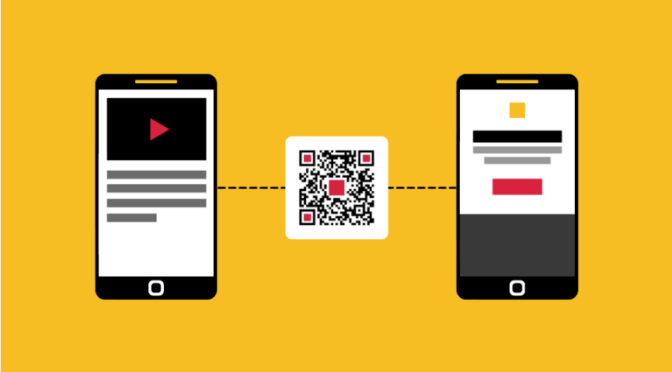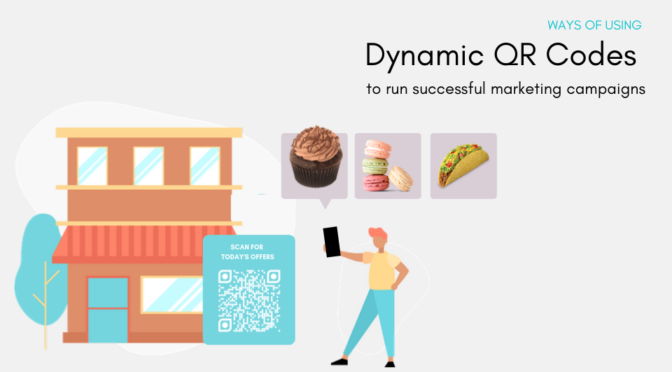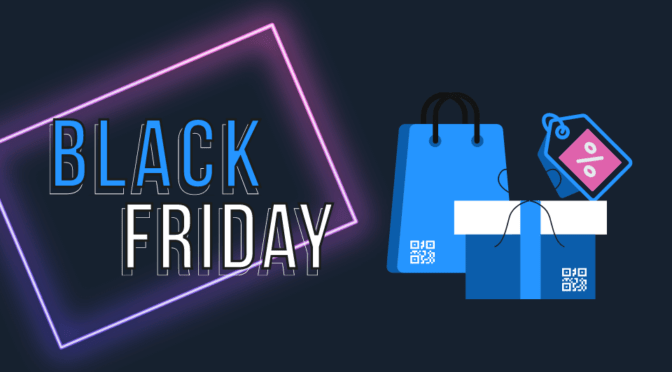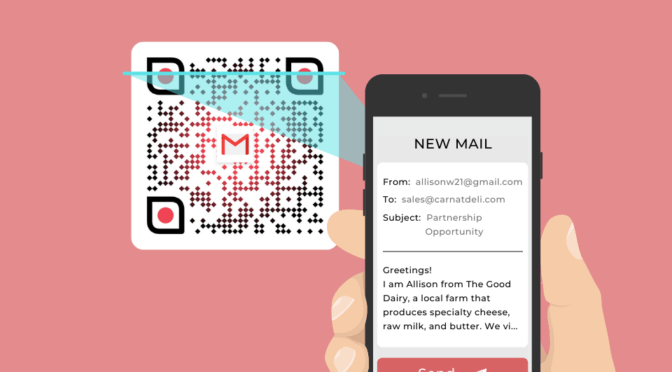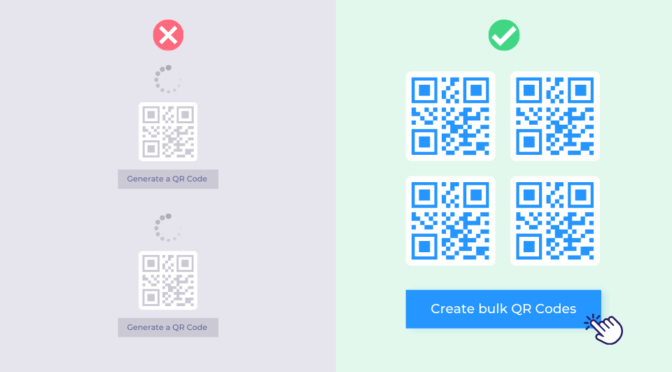💻 Key takeaways:
1. Dynamic QR Code is an editable QR Code that lets you change the content, is trackable, and customizable.
2. Their benefits over static QR Codes help diverse industries share content via QR Codes for menus, app downloads, brochures, billboards, etc.
3. Best practices for dynamic QR Codes include ensuring content is accessible, branding the QR Code, using the right format, and testing the QR Code before deploying.
Let’s say you’ve set up an advertising campaign with QR Codes on a digital billboard for a stadium for a fun poll.
But when fans scan, they see a 404 error. The cause? There is a small typo in the URL. If it is a static QR Code, you’re stuck. With a dynamic QR Code, you could quickly fix the issue by editing the URL and pointing your audience to the correct content.
So what is a dynamic QR Code, and why is it the better choice? Here is all you need to know.
Table of contents
- What are dynamic QR Codes?
- How do dynamic QR Codes work?
- How are dynamic and static QR Codes different?
- What are some advantages of using dynamic QR Codes?
- Bonus: How to choose your dynamic QR Code generator—a feature checklist
- How to create a dynamic QR Code (steps + tips)
- 10 Real-world examples of dynamic QR Code uses
- Choose the right QR Code management platform for your dynamic QR Codes
- Frequently asked questions
What are dynamic QR Codes?
Unlike static QR Codes, which are permanently linked to a specific piece of data, dynamic QR Codes are editable and trackable—you can change the content or URL embedded in them even after they have been printed or distributed.
Dynamic QR Codes also bundle other advanced features that static QR Codes don’t offer, such as:
- Tracking scans
- The ability to customize the QR Code designs
- Embedding a wider variety of content
- Intelligently pointing to multi-language content based on a person’s device locale
- Using logic jumps to serve content, among many other things
For example, a restaurant can use a dynamic QR Code to point to an online menu. They can update the link without reprinting the QR Code if the menu changes.
How do dynamic QR Codes work?
Here’s how dynamic QR Codes work:
1: Generating a QR Code
When you generate a dynamic QR Code, the final data (for example, a lengthy URL) is not directly embedded into the code. Instead, the QR Code generator creates a short URL and stores it on an encrypted server. This short URL is what’s embedded in the QR Code.
2: Scanning dynamic QR Code
When someone scans the dynamic QR Code, their device reads the short URL and redirects them to the destination content. This destination could be a website, video, PDF, form, or other online content.
Now, because there is a short URL that “redirects” to the actual content in a dynamic QR Code, you can change it “dynamically” at any time without redesigning or reprinting it.
How are dynamic and static QR Codes different?
Static QR Codes have many limitations and don’t offer the flexibility that dynamic QR Codes do.
This table summarizes the main differences between the two:
| Feature | Static QR Code | Dynamic QR Code |
| ✏️ Content editability | Not editable once created | Editable even after deployment |
| 🫙 Data storage | Directly embedded in the code | Links to an external secured server or database |
| 🔎 Tracking and analytics | Not trackable | Trackable (scans, locations, devices, etc) |
| 🎨 Size and design | Larger patterns, depending on data | Compact, regardless of data complexity due to short URL |
| 💰 Cost | Mostly free (even on Uniqode) | Usually comes with a subscription fee because of advanced marketing-focused features |
Related: Learn more about static vs. dynamic QR Codes
🔥Do you know? Dynamic QR Codes scan faster than static QR Codes
This is because they have shortened URLs converted into QR patterns.
And because the URL is short, the data patterns are not as dense as regular QR Codes with lengthy URLs. This makes it easy for cameras and QR scanners to process them, making your QR Codes look cleaner and point to the destination content faster.
“I personally performed internal tests where I scanned the Uniqode QR Code from a distance of 30 feet from the television without zooming in. And I was able to do that in less than 0.5 seconds!”
— Pratik Shetty, Senior Director of Customer,
Flipkart
What are some advantages of using dynamic QR Codes?
They say print errors stay forever. Not if you’re using a dynamic QR Code.
Here are some key advantages of using dynamic QR Codes:
- Editability
With dynamic QR Codes, you can change the QR Code destination or content per your requirements—without reprinting the QR Code.
Think of a coffee packet with a dynamic QR Code. This QR Code can link to cold coffee recipes in the summer and steaming cappuccino and mocha recipes in the winter [thank me later].
2. Customization
The practical beauty of dynamic QR Codes is that you don’t always have to settle for plain, black-and-white codes. You customize them to make them on-brand.
For example, if you are using Uniqode, you can:
- Change the color of the QR patterns
- Add brand logo in the middle
- Change QR Code shape
- Add a background: image, pattern, solid color
- Add a CTA text to the QR Code
- Add a custom domain to link the QR Code
Customizing your dynamic QR Code can help build trust, credibility, and brand recall, which can be equity for bigger brands.
⭐ Real people. Real results.
“It was extremely important for us to link our QR Codes to a custom domain: having “/sportsthread” in the link meant that more people would click through. No one wants to click a link with random letters and numbers. It feels spammy.”
— Keenan Leary, Director, UI/UX, Sportsthread
3. Tracking and analytics
Insights driven from your QR Code can help you measure your campaign’s impact and tweak your efforts to ensure you’re engaging the right audience.
Moreover, with a dynamic QR Code, you can optimize campaigns in real-time by redirecting to a new URL, offer, or updated promotion. You can even perform A/B tests on different CTAs or designs to measure effectiveness.
On Uniqode, you can track metrics such as the number of scans, unique users, time and day of scans, city, country, best-performing campaigns, etc.
You can also integrate Uniqode with Google Analytics to analyze your performance, demographics, interests, and even compare campaigns.
⭐ Real people. Real results.
“The analytics on Uniqode has been super easy to use and organize. Because of the campaign label function, it became effortless for us to go in and look for specific campaigns. Once the campaigns are sorted, we can begin seeing all the metrics tied into them.”
— Kinsey Akins, Programmatic Channel Manager, BBQ Guys
4. Bulk generation
If you deal with a high volume of product or inventory or operate globally, being able to bulk-generate dynamic QR Codes is essential.
A typical example would be if you require inventory management or wish to simplify event management. Imagine doing any of that with static QR Codes!
With dynamic QR Codes, you can encode more information, offer sophisticated tracking and analytics, and save time, money, and effort.
With Uniqode, you can use Google Sheets or Excel to assign links to your QR Codes and customize and deploy them using a bulk QR Code generator.
5. Integrations
Combine the power of dynamic QR Codes with your most-used work software or tool, and the possibilities become endless. Imagine using QR Codes to track your class attendance in an academic setting.
Each time a student scans their assigned QR Code, you can automate an entry in your Excel or spreadsheet, checking off an attendance. If you use Uniqode, you can integrate QR Codes with your CRM and apps such as Slack and Google Analytics, to name a few.
6. Security
Dynamic QR Codes are inherently more secure than static ones as they come with a layer of security that static QR Codes lack. Remember the redirection I talked about before?
Beyond the platform-level encryption such as GDPR, SOC 2® Type 2, and HIPAA, a QR Code management platform like Uniqode also has operation-level security arrangements so that you can collaborate with your team members on the same dashboard without compromising security.
Authentication and authorization features, such as password protection or access controls, can help you restrict or relinquish access to data. These measures can enhance security by limiting who can interact with the QR Code from your organization.
Also read: Why Uniqode is the safest QR Code generator
7. Interactivity
With dynamic QR Codes, you can use advanced functionalities such as redirection based on time, location, or device type. This feature is called Smart Rules on Uniqode.
For example, you can offer a personalized user experience by triggering varied actions based on pre-defined rules. Imagine content redirection, but dynamic, based on the time of the day, the number of scans, or any rule you set.
For example, your QR Code menu could change according to the time of day, offering morning brunch or dinner main courses to scanners based on what time they scan the QR Code.
Read more: Smart QR Codes
Bonus: How to choose your dynamic QR Code generator—a feature checklist
Read more: Best Dynamic QR Code Generators Compared
How to create a dynamic QR Code (steps + tips)
The easiest way to generate a dynamic QR Code is using Uniqode’s dynamic QR Code generator. Follow the simple steps below:
Step 1: Log in to the dashboard and click “+Create”
To access the Uniqode dashboard, you can sign up for a free trial. Once you log-in to the dashboard, click “+Create” and “QR Codes.”
Step 2: Choose the type of dynamic QR Code
You can use dynamic QR Codes to show varied content, from PDFs to landing pages.
Step 3: Insert the URL of the content
For example, if you plan to share a PDF, you can choose the “PDF” option and either upload the PDF or insert the URL if it is hosted online.
Enable the sharing settings so your audience can view it.
Step 4: Customize the dynamic QR Code
You can customize the dynamic QR Code as per your branding:
- Customize the eyes and the eye shape
- Customize the data pattern, change its color, or add a gradient
- Go for a color background, add an image, or keep it transparent
- Add a QR Code border
- Add a CTA that provides a preview of where the QR Code leads to
Step 5: Download the dynamic QR Code in the format of your choice
You can download the dynamic QR Code in formats such as PNG and JPEG (suitable for use on printed materials).
For resizing purposes or use on larger materials and screens, go for high-quality QR Code formats such as SVG and EPS.
💡Pro Tip: Using QR Codes on larger materials such as billboards subjects them to wear and tear due to conditions such as the weather, the geography of the area, etc. You can avoid the effects of any minor damage by enabling error correction. This ensures that your QR Codes function despite any damage to the pattern. Learn more about error correction.
10 Real-world examples of dynamic QR Code uses
- 🍔 Menu QR Codes: contactless, paperless, more savings
Marriott Aruba, a premium beachfront resort, replaced all restaurant print menus with dynamic QR Codes after COVID-19. This implementation of QR Codes led to cost savings of around $150,000 by reducing printing.
⭐ Real people. Real results.
“Given the circumstances of the pandemic, we have been using Uniqode’s (formerly Beaconstac) QR Codes primarily for restaurant menus. We’re also adopting it for other use cases like explaining procedures to our guests at our towel huts.”
— Noemi Tromp, Marketing Executive, Aruba Marriott Resort
With a dynamic QR Code menu, Noemi’s team could change it based on the day. So, in the morning, one could view the breakfast menu; later in the day, only the lunch menu; and finally, at night, one could skim through the dinner menu—thus leading to savings on printing costs.
- 📽️ Movie QR Codes: lights, camera, agility
From Deadpool vs. Wolverine to Barbie, QR Codes have become an addition to movie marketing campaigns and a trending use case for cinema advertising.
Lionsgate, North America’s largest mini-major film studio, used Uniqode’s dynamic QR Codes to craft localized and targeted marketing campaigns to promote their films.
“I wanted the ability for the QR Codes we deploy to change their destination, whether a different giveaway, sweepstake, or any type of promo. We also didn’t want to print the same collateral en masse twice,” said Mike Caballes, digital marketing consultant at Lionsgate.
In one of their campaigns, the company recorded 12,000+ engagements across 65+ cities. “The platform [Uniqode] has performed great. Based on our ROI, it’s been terrific.”
- 🛍️ Retail QR Codes: direct mail with robust analytics
Insights driven by your QR Code can help you measure your campaign’s effectiveness and tweak your efforts to ensure you’re engaging the right audience.
Moreover, with a dynamic QR Code, you can optimize real-time campaigns by redirecting to a new URL, offer, or promotion.
BBQGuys, America’s premier retailer of grilling and outdoor living equipment, used QR Code analytics to measure the effectiveness of its direct mail campaigns.
BBQGuys sent direct mail with a QR Code to anyone spending time on their website. Since the campaigns were fully automated and perpetual, the brand needed a QR Code platform to match its pace and scale.
According to Kinsey Akins, the brand’s programmatic channel manager, Uniqode’s analytics did something no one else did well: data organization.
“The analytics on Uniqode have been super easy to use and organize. Because of the campaign label function, it became effortless for us to go in and look for specific campaigns. Once the campaigns are sorted, we can see all the metrics tied into them.”
- 🌍 Multi-language QR Codes: from local to global marketing
Imagine sharing content with a user based on their preferred language. That’s possible with multilingual QR Codes. It can be a game-changer if you cater to a global audience through marketing campaigns.
Here’s how Hong Kong’s first-ever museum, M+, used Uniqode to drive 148,000+ visitor engagements and 113,000+ unique interactions using dynamic QR Codes.
According to Diane Wang, head of digital technology at M+: “I think Uniqode was the only platform we’ve looked at that had multilingual support. That really intrigued us because that’s something we could grow into since we support multiple languages. Without multilingual support, the alternative would be to have one QR Code per language, which, as you know, might confuse visitors.”
- App download QR Code: increase app downloads across the OS
You can use an app download QR Code to direct users to the appropriate app stores (Apple App Store or Google Play Store) based on your prospect’s device operating system.
This simplifies promoting your app and increases downloads because users don’t have to search for it manually in their app store.
You can customize the QR Code per your branding (or OS) and share it across flyers, brochures, and so on instead of creating a static QR Code for each app and OS.
➡️Read how Sportsthread uses Uniqode to drive 1,000,000 app downloads
- Digital business cards for sustainable and memorable networking
Networking events are a great way to capture leads. However, digital business cards are the better solution to ensure that lead generation doesn’t just stop at exchanging paper business cards, which are prone to being misplaced.
Digital business cards are dynamic QR Codes that lead to a page with your contact information, email, social media links (such as LinkedIn), or any other links you put.
Recipients can save your digital business cards on their mobile devices, making revisiting your contacts easier after the event. This also saves you the cost of printing paper business cards.
➡️Read how Polycor enhanced sales engagement and sustainability with Uniqode’s digital business cards.
- Inventory management for real-time tracking
Dynamic QR Codes for inventory management can help you update real-time inventory data. This overcomes the limitation of static QR Codes, which mostly hold limited product information and serial numbers.
With dynamic QR Codes, you can redirect scanners to a tracking page or a landing page to reflect the package’s current status. This makes tracking and managing inventory easier. Plus, users with a mobile device can scan the QR Code and instantly view information, making the whole process more efficient.
➡️Also read: Our simple guide to using QR Codes for inventory management
- Packaging QR Codes: enhanced engagement and transparency
With dynamic QR Codes on product packaging, you can redirect the audience to promotional pages, usage instructions, updated recipes, or links to any other resources.
For example, brands such as Cocokind and Lush use dynamic QR Codes to point users to information about sustainability and their products.
Consumers can scan the QR Code for the latest insights, interactive content, or coupons, fostering better brand-consumer interaction and a personalized experience with your product.
- Review QR Code: more reviews, less hassle
You can use dynamic QR Codes to redirect your audience to the review page of your choice. Be it Google reviews or Yelp, you can point consumers to your business profile or have a landing page with different platforms to review based on their preference or the product they purchased.
This tailored approach encourages more reviews by allowing customers to share their feedback. Additionally, if you decide to change review platforms or update your process, you can update or edit links if it’s a dynamic QR Code, ensuring customers can leave their reviews.
➡️ Also read: How to use a Google review QR Code to boost reviews
- Event QR Code: a perfect balance of offline and online
If you use dynamic QR Codes correctly, they can play a big role in your event’s success, from registration to engagement during an event or the follow-up.
An easy application of event QR Codes is to let attendees scan to view a dynamic event agenda, a venue map, speaker information, etc., all of which you can update in real time.
➡️Read how Mr Apple, New Zealand’s largest apple grower, uses dynamic QR Code stickers to boost event participation
Choose the right QR Code management platform for your dynamic QR Codes
With so many QR Code generators in the market, you might be confused about which one to choose.
We’ve made it easier by listing out a comparison below to help you make the right choice:

Frequently asked questions
1. How do I know if my QR Code is static or dynamic?
Visually, static QR Codes are often associated with their black-and-white look, while dynamic QR Codes are customizable and have less dense data patterns. If you’re still unsure whether a QR Code is static or dynamic, try scanning it. If you can see a short URL such as “qrcodes.pro” that points to the website, it is a dynamic QR Code. Static QR Codes prompt you to open the website directly, for example, “www.uniqode.com”.
2. How do I create a free dynamic QR Code?
You can sign up for Uniqode’s 14-day free trial to create a dynamic QR Code at zero cost. After signing up for a free trial:
- Log in to the Uniqode dashboard.
- Choose “QR Codes” and choose the QR type.
- Enter all relevant information.
- Customize your dynamic QR Code.
- Generate, test, download, deploy code.
However, remember to upgrade to a paid plan after the trial period ends to continue using your dynamic QR Codes.
3. Can you convert your dynamic QR Code to a static one?
No, you cannot convert your dynamic QR Code to static or vice versa. This is because static QR Codes encode the information in their data pattern and have limited features compared to dynamic QR Code features, such as editability, trackability, etc. Both are two distinct types of QR Codes.
4. How much does a dynamic QR Code cost?
Dynamic QR Codes often come with a cost due to their features over static QR Codes. Dynamic QR Code pricing starts at about $15 for three dynamic QR Codes, and prices can differ based on the number of QR Codes and additional features needed.
5. Why do dynamic QR Codes cost money?
Dynamic QR Codes offer many features, such as customization, tracking, editability, etc., that static QR Codes don’t. Static QR Codes are free for their limited features, but dynamic QR Codes start from as low as $5 for all these additional features.
Monika Adarsh is the Director of Inbound Marketing at Uniqode where her primary job is to help users find answers to anything related to QR Codes. She works closely with customers to understand QR Code usage trends and build a framework for successful QR Code campaigns. She enjoys documenting her learnings about the QR Code market as posts and playbooks. She also anchors a podcast to uncover ways of using QR Codes in DTC/CPG brands. In her free time, she loves gardening and decorating spaces.







